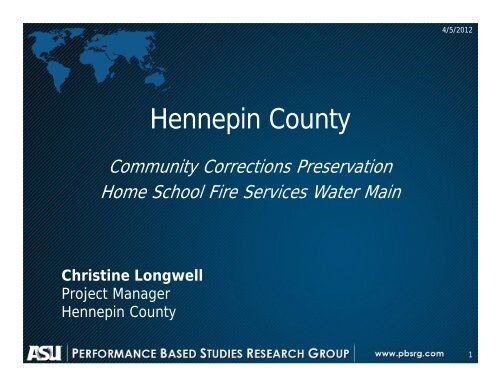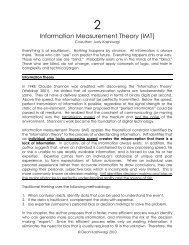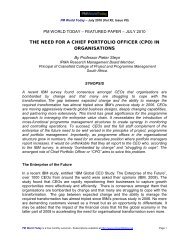Hennepin County - Performance Based Studies Research Group
Hennepin County - Performance Based Studies Research Group
Hennepin County - Performance Based Studies Research Group
You also want an ePaper? Increase the reach of your titles
YUMPU automatically turns print PDFs into web optimized ePapers that Google loves.
4/5/2012<br />
<strong>Hennepin</strong> <strong>County</strong><br />
Community Corrections Preservation<br />
Home School Fire Services Water Main<br />
Christine Longwell<br />
Project Manager<br />
<strong>Hennepin</strong> <strong>County</strong><br />
1
This presentation is for<br />
educational purposes only.<br />
Please refer to the RFP for<br />
specific instructions<br />
2
Schedule<br />
Date<br />
Activity<br />
03‐28‐12 RFP Released<br />
04‐04‐12 Pre‐Proposal Mtg – Best Value Training – 9:00am – 9:30am<br />
04‐04‐12 Pre‐Proposal Mtg – Site Walkthrough – 9:30am (RECOMMENDED)<br />
04‐11‐12 Last Day For Questions<br />
04‐18‐12 Proposals Due (2:00 PM Minnesota Time)<br />
05‐02‐12 Interviews<br />
05‐07‐12 Identification of Potential Best‐Value<br />
05‐14‐12 Pre‐Award Kick Off Meeting<br />
05‐29‐12 Final Pre‐Award Meeting<br />
06‐14‐12 Project Award<br />
12‐07‐12 Substantial Completion Date<br />
3
Small Business Enterprise Program (SBE)<br />
• <strong>Hennepin</strong> <strong>County</strong> adopted the SBE Program to break<br />
down barriers in the marketplace and encourage<br />
increased competition.<br />
• A SBE Participation Goal of up to 25% can be set on any<br />
construction opportunity.<br />
• This goal must be met by attainment or documentation<br />
of Good-Faith Efforts.<br />
• Good-Faith Effort Guidelines are included in the<br />
Specifications.<br />
4
Small Business Enterprise Program (SBE)<br />
While firms do not have to be certified to do business with<br />
<strong>Hennepin</strong> <strong>County</strong>, only those certified as SBE’s with our CERT<br />
Program count toward the SBE Goal Attainment. Participation<br />
approval is necessary prior to contract award.<br />
CERT Program directories are no longer posted online. If you<br />
already have a B2Gnow login, you will be able to access the<br />
directory by logging in and selecting “Search”…If you do not<br />
have a login ID, send an email to cert@ci.stpaul.mn.us with the<br />
project name and due date, the government agency bidding out<br />
the project. Include your contact name, company, phone & fax<br />
number, and email address. Allow 24 hours for someone to<br />
respond to your request.<br />
5
Small Business Enterprise Program (SBE)<br />
When submitting documentation, include all of your Bid<br />
Solicitation information: Telephone Logs used to solicit<br />
subcontractors, with contact person and telephone<br />
number; copy of letter/fax notification used to contact<br />
contractors requesting their participation; detail of<br />
responses: No Response/No Bid/if bidding, amount bid.<br />
Contact: Angie Kirkpatrick, 612.348.2528 for questions<br />
regarding SBE.<br />
6
Best Value Objectives<br />
• Transfer risk to experts (not just transfer risk...but<br />
minimize risk)<br />
• Minimize risk of non-performance<br />
– Complete to the expectations<br />
– Customer satisfaction / No complaints<br />
• Minimize client management, direction, and decision<br />
making.<br />
7
Best Value System: Three Phases<br />
(alignment of expertise, minimization of effort)<br />
Vendor is an Expert<br />
Vendor is an Expert<br />
PHASE 1<br />
Identification<br />
of Potential<br />
Best-Value<br />
PHASE 2<br />
Pre Planning<br />
and<br />
Quality Control<br />
PHASE 3<br />
Award |<br />
Measurement &<br />
Documentation<br />
Vendor is NOT an Expert<br />
8
Submittals<br />
Phase 1<br />
Selection
Selection Steps<br />
Phase 1<br />
Selection<br />
STEP 1<br />
Risk, Project<br />
Capability, Value<br />
Add, Cost, Past<br />
<strong>Performance</strong>,<br />
Schedule Vendor<br />
STEP 2<br />
Interviews<br />
Vendor<br />
STEP 3<br />
Prioritization<br />
Vendor<br />
STEP 4<br />
Cost<br />
Reasonableness<br />
Vendor<br />
10
Dominant ratings…<br />
Phase 1<br />
Selection<br />
• Support claims with:<br />
– verifiable performance metrics<br />
– best value practices with performance measurements<br />
11
Selection Criteria<br />
Phase 1<br />
Selection<br />
• Paper Submittals:<br />
– Risk that vendor does not control (Risk)<br />
– Project Capability (PC)<br />
– Value Added (VA)<br />
• Interview<br />
• Cost<br />
• Past <strong>Performance</strong> Information (PPI)
Risk Plan<br />
13
Risk Plan<br />
Phase 1<br />
Selection<br />
• Prioritize major risk items on this project that the<br />
submitter does NOT control<br />
• Explain how proposer will mitigate, manage, and/or<br />
minimize the risk from occurring<br />
– Was the mitigation plan was used previously, how many times<br />
– What was the impact on performance in terms of cost, schedule<br />
and customer satisfaction
Risk Plan Template<br />
Phase 1<br />
Selection<br />
15
Risk Plan Example<br />
Phase 1<br />
Selection<br />
Risk Description:<br />
Solution:<br />
Unforeseen risk or conditions are discovered on the project.<br />
Risk that is not identified by client professional, competing contractors, or expert contractor<br />
will be identified and solved within 3 days maximum (unless longer time is justified and<br />
requested). The contractor will resolve unforeseen risks in the following manner:<br />
• Contractor shall immediately notify the designer and owner the same day as discovery<br />
of potential cost and time impact<br />
• Contractor shall find best possible options to minimize risk, with accompanying cost and<br />
time<br />
• All cost and time figures will be competed among the best performers<br />
• Contractor shall propose the best solution with justification and present to client<br />
representative<br />
• If client representative approves, no action required, as contractor will create change<br />
order for work, justification, pricing, and proposal within the specified time, and<br />
proceed to accomplish the work<br />
• If client objects, contractor will work around issue and document cost and time<br />
deviation on a weekly basis<br />
Documented<br />
<strong>Performance</strong>:<br />
Of our 15 most recently completed projects in similar scope to this project, less than 1% of<br />
the deviations were unforeseen. Our average response time from identification of<br />
unforeseen risk to issuance of RFI is 1 day (for these same 15 projects).<br />
16
Project Capability Plan<br />
17
Project Capability Plan<br />
Phase 1<br />
Selection<br />
• Proposer’s opportunity to highlight capability to meet the<br />
requirements of this project through the use of best<br />
value practices and/or performance metrics<br />
• Identify "vision” or “plan” for the alignment of expertise<br />
over the duration of the project<br />
– Alignment of Resources<br />
– Cash flow<br />
– Selection of critical sub-vendors
Project Capability Plan Template<br />
Phase 1<br />
Selection<br />
ATTACHMENT D<br />
Project Capability Plan<br />
This template must be used. The Project Capability Plan should identify the Respondent’s capability to<br />
meet the project’s requirements with a plan that meets time and cost goals. The capability claims<br />
should be prioritized (list the most important claims first). The Respondent may add or delete Project<br />
Capability Claim table templates, but do not exceed the 2-page limit. Do NOT include any identifying<br />
information in your Plan. Information listed under the “Documented <strong>Performance</strong>” line may describe<br />
where the Respondent has used the approach or solution previously, and what the results were in terms<br />
of verifiable metrics.<br />
Project Capability 1 Claim:<br />
Documented <strong>Performance</strong>:<br />
Project Capability 2 Claim:<br />
Documented <strong>Performance</strong>:<br />
Project Capability 3 Claim:<br />
Documented <strong>Performance</strong>:<br />
Project Capability 4 Claim:<br />
Documented <strong>Performance</strong>:<br />
19
Project Capability Plan Example<br />
Phase 1<br />
Selection<br />
Submittal with historical performance information<br />
Capability<br />
Claim:<br />
Our roofing subcontractor has proven long‐term performance to<br />
eliminate leaks caused by the roofing system, at a very high level<br />
of customer satisfaction.<br />
Documented<br />
<strong>Performance</strong>:<br />
The roofing contractor has completed 25 roofing projects (similar<br />
size and scope to this project) with an average age of 12 years.<br />
99% of the projects were completed on‐time, 95% of the roofs<br />
have never leaked, and 100% of the roofs do not currently leak.<br />
The average overall customer satisfaction rating is 9.5 out of 10.
Value Added Plan<br />
21
Value Added Plan<br />
Phase 1<br />
Selection<br />
• Opportunity to identify any value added options or ideas that<br />
may benefit the <strong>County</strong><br />
• Respondent should identify:<br />
– What the Owner may have excluded or omitted from its<br />
scope<br />
– How these options or ideas have been successful through<br />
verifiable performance information and/or best value<br />
practices<br />
• MUST have a cost impact (and possibly schedule impact)
Value Added Plan Template<br />
Phase 1<br />
Selection<br />
23
Value Added Example<br />
Phase 1<br />
Selection<br />
Item 1 Claim:<br />
How will this add value<br />
There are 14 issues with the design that, if left<br />
unchanged, will result in a finished project that does<br />
not meet the Owner’s intent.<br />
Resolving the issues before they arise will save<br />
approximately 20% cost, and 5% in time.<br />
Documented performance: On 5 similar projects to this one, we identified and<br />
resolved an average of 12 issues per project prior to<br />
award. These projects resulted in less than 2% designrelated<br />
cost change orders, and no schedule delays.<br />
Cost Impact (%): 3.5%<br />
Schedule Impact (%): 0%
Milestone Schedule<br />
25
Milestone Schedule<br />
Phase 1<br />
Selection<br />
• Identify major items that affect final completion of<br />
project<br />
• Identify where client actions and decisions are needed<br />
• Risk is anything that causes deviation to the plan<br />
26
Things to Avoid<br />
Phase 1<br />
Selection<br />
• Transferring risk back to client:<br />
– We will work with the owner to resolve issues<br />
– We will have team meetings / partnering meeting with the owner<br />
• General risks and/or general solutions:<br />
– We will plan ahead to coordinate activities<br />
– We will plan ahead to get classes scheduled and created<br />
27
Submittal Requirements<br />
Phase 1<br />
Selection<br />
Submittal Document<br />
Risk Plan<br />
Project Capability Plan<br />
Value Add Plan<br />
Maximum Page Length<br />
Two (2) pages<br />
Two (2) pages<br />
Two (2) pages<br />
• Must not contain ANY identifying information (names, company<br />
names, project names, product names, etc.)<br />
• Vendors are NOT allowed to re-create, re-format, or modify the<br />
template (cannot alter font size, font type, font color; add colors,<br />
pictures, tables, diagrams, etc)<br />
• Must use template provided on website – www.pbsrg.com<br />
28
Past <strong>Performance</strong> Information Submittal<br />
Phase 1<br />
Selection<br />
VENDOR Vendor<br />
Step 1<br />
Step 2<br />
Step 3<br />
Step 4<br />
Step 5<br />
Prepare Reference List<br />
Prepare and Send Survey Questionnaires to Past Clients<br />
Collect/Receive Completed Surveys<br />
Enter data into Reference List<br />
Package all material (Reference List and Surveys) and Submit
Step 1: Prepare Reference List<br />
Phase 1<br />
Selection<br />
Profile sheet<br />
SURVEY<br />
CODE<br />
FIRST<br />
NAME<br />
LAST NAME PHONE FAX<br />
CLIENT<br />
NAME<br />
PROJECT NAME<br />
DATE<br />
COMPLETED<br />
COST OF<br />
PROJECT<br />
PROJECT<br />
TYPE<br />
Past Project Info sheet<br />
30
Step 2: Prepare & Send Surveys<br />
Phase 1<br />
Selection<br />
Past Project<br />
Info<br />
Profile<br />
Send<br />
Client<br />
31
Step 3: Survey Form<br />
Phase 1<br />
Selection<br />
NO CRITERIA UNIT RATING<br />
1 Ability to manage the project cost (minimize change orders) (1-10)<br />
2 Ability to maintain project schedule (complete on-time or early) (1-10)<br />
3 Quality of workmanship (1-10)<br />
4 Professionalism and ability to manage (1-10)<br />
5 Close out process (1-10)<br />
6 Communication, explanation of risk, and documentation (1-10)<br />
7 Ability to follow the users rules, regulations, and requirements (1-10)<br />
8 Overall customer satisfaction and comfort level hiring again (1-10)<br />
32
Step 4: Sign & Fax<br />
Phase 1<br />
Selection<br />
33
Step 5: Collect & Receive Surveys<br />
Phase 1<br />
Selection<br />
Past Client<br />
Fax, Email, Mail<br />
Contractor<br />
34
Step 6: Fill Out Reference List<br />
Phase 1<br />
Selection<br />
35
Step 7: Scan Surveys & Burn CD<br />
Phase 1<br />
Selection<br />
Reference Lists<br />
Returned Surveys<br />
Excel (XLS) file<br />
scanned to PDF<br />
CD‐ROM<br />
36
I already have PPI…<br />
Phase 1<br />
Selection<br />
<br />
37
Summary of PPI Requirements<br />
Phase 1<br />
Selection<br />
• Maximum number of surveys that can be evaluated for each<br />
critical team component is 5 for a company and 3 for an<br />
individual<br />
• Projects must be 100% complete (final payment received)<br />
• Project list must contain different projects<br />
• The survey must be signed<br />
• Turn in electronic copies of surveys (PDF) and Reference Lists<br />
(XLS)<br />
• Projects do not need to be similar<br />
38
Comments / Questions on PPI Submittal<br />
Jake.Smithwick@asu.edu<br />
www.pbsrg.com<br />
39
Submittal Process<br />
40
How The Submittal Process Works<br />
Phase 1<br />
Selection<br />
Average<br />
Score<br />
Submittal<br />
Contracting<br />
Officer<br />
Proposal Form, $, &<br />
Proposal Form<br />
Other Documentation<br />
(1 page)<br />
Risk, Project Capability,<br />
Proposal Form<br />
Value Added (1 page) Plans<br />
Evaluation Members<br />
41
Selection Steps<br />
Phase 1<br />
Selection<br />
STEP 1<br />
STEP 2<br />
STEP 3<br />
STEP 4<br />
Risk Assessment,<br />
Value Add, Cost,<br />
Vendor PPI<br />
Interviews<br />
Vendor<br />
Prioritization<br />
Vendor<br />
Cost<br />
Reasonableness<br />
Vendor<br />
42
Looking for the expert<br />
Phase 1<br />
Selection<br />
Project<br />
Risk Risk Risk<br />
43
Interview Format<br />
Phase 1<br />
Selection<br />
• The client will actually “interview” each critical individual. This is not a<br />
“presentation”:<br />
– Project Manager<br />
– Site Superintendent<br />
• All individuals will be interviewed separately. The client will not allow group<br />
interviews with the vendor’s team. The client will not allow any other<br />
individuals to be present during interviews<br />
• Generally, interview times will last about 15-20 minutes per individual<br />
• A standard set of questions will be generated and asked to each individual.<br />
• The client has the option to clarify any answers (or ask additional questions<br />
to clarify an answer).<br />
• No substitutions will be allowed. Individuals listed on Proposal Form must<br />
be present. If a team member is not present for the interview, they will<br />
jeopardize the teams competitiveness.<br />
44
Selection Steps<br />
Phase 1<br />
Selection<br />
STEP 1<br />
STEP 2<br />
STEP 3<br />
STEP 4<br />
Risk Assessment,<br />
Value Add, Cost,<br />
PPI, Vendor Schedule<br />
Interviews<br />
Vendor<br />
Prioritization<br />
Vendor<br />
Cost<br />
Reasonableness<br />
Vendor<br />
45
Cost Reasonableness<br />
Phase 1<br />
Selection<br />
Best Value<br />
Prioritization<br />
Dominance Check Also<br />
Best-Value is within budget<br />
Best-Value is the lowest price<br />
Best-Value is within 5% of<br />
next highest ranked firm<br />
Best-Value can be justified<br />
based on other factors<br />
Yes<br />
Yes<br />
Yes<br />
No Yes<br />
No Yes<br />
Yes<br />
No Yes<br />
Proceed to highest ranked<br />
proposal within budget<br />
No Yes<br />
Proceed to<br />
Pre-Award<br />
Go with Alternate<br />
Proposal or Cancel<br />
46
Summary of Evaluation Factors<br />
Phase 1<br />
Selection<br />
Rank Evaluation Factor Weighted Rated<br />
1 Interview X X<br />
2 Cost X<br />
3 Risk Assessment X X<br />
4 Technical Capability X X<br />
5 Value Add X X<br />
6 Past <strong>Performance</strong> Information X<br />
N/A<br />
Milestone Schedule<br />
47
Pre-Award/Clarification<br />
48
PIPS Process<br />
PHASE 1<br />
Identification<br />
of Potential<br />
Best-Value<br />
PHASE 2<br />
Pre Planning<br />
and<br />
Quality Control<br />
PHASE 3<br />
Award |<br />
Measurement &<br />
Documentation<br />
49
Pre-Award/Clarification Schedule<br />
Phase 2<br />
Pre-Award<br />
1. Notification of Potential Best Value (1 week prior to Kick-off<br />
meeting)<br />
2. Kick-off Meeting with Proposer and <strong>County</strong> Project Team<br />
3. Clarification Phase (2 weeks)<br />
– Determine acceptance of Value Added items<br />
– Answer outstanding questions from Kick-off meeting<br />
– Prepare Revision Document to document all changes<br />
4. Close-out Meeting<br />
5. Contract Finalization<br />
6. Notice to Proceed<br />
50
Pre-Award/Clarification Kickoff Meeting<br />
Phase 2<br />
Pre-Award<br />
• Attendees include designer, user, client, critical<br />
subcontractors, and critical personnel<br />
• Contractor presents technical scope and Risk<br />
Management Plan (RMP)<br />
• Client, user, and technical experts quiz vendor on both<br />
technical and non-technical concerns<br />
• Input from kickoff meeting is put into technical<br />
specifications and Weekly Risk Report/RMP<br />
51
Pre-Award/Clarification Phase<br />
Phase 2<br />
Pre-Award<br />
• Preplan the delivery of the project<br />
• Clarify that the proposal is accurate (get details)<br />
• Identify the risks/issues that could cause the plan to deviate<br />
• Identify your assumptions and what you do no know<br />
– Set plans to minimize those risks from occurring<br />
– Address all the concerns and risks of the client<br />
• Identify what is needed from the <strong>County</strong> and the a plan for<br />
getting it<br />
• Align expectations between all parties so everyone knows<br />
what is going to transpire and what they are supposed to do<br />
52
Pre-Award/Clarification Closeout Meeting<br />
Phase 2<br />
Pre-Award<br />
• Closeout meeting is to summarize all of the coordination<br />
that has been complete and walk through the Pre-Award<br />
Document<br />
– All issues resolved<br />
– All coordination complete<br />
– All risks that are not in vendors control have been identified<br />
– All value added options have been addressed<br />
• Upon successful completion of the Closeout Meeting, the<br />
client will make the award<br />
53 53
Summary<br />
Phase 2<br />
Pre-Award<br />
• The PA Phase is the most important step in the best-value process<br />
• It is a period of time that is used to preplan the entire project in<br />
detail (minimize surprises / identify all risks the vendor does not<br />
control)<br />
• The vendor is in control of this phase, but the client should facilitate<br />
• The PA Document must contain<br />
– Base Cost + Value Added Items = Final Cost<br />
– Documentation of decisions during PA<br />
– Schedule<br />
– Risk Management Plan<br />
– Uncontrollable risks
PIPS Process<br />
PHASE 1<br />
Identification<br />
of Potential<br />
Best-Value<br />
PHASE 2<br />
Pre Planning<br />
and<br />
Quality Control<br />
PHASE 3<br />
Award |<br />
Measurement &<br />
Documentation<br />
55
Weekly Reporting System (WRS)<br />
• Excel Spreadsheet that tracks only unforeseen risks on a<br />
project<br />
• Client will setup and send to vendor once Award/Notice to<br />
Proceed issued<br />
• Vendor must submit the report every week (Friday).<br />
• The final project rating will be impacted by the accuracy and<br />
timely submittal of the WRS<br />
56
www.pbsrg.com/pips
More Education
NEW! PIPS WEB UPDATES<br />
• Want to stay updated on PIPS Projects<br />
• Get an email when a project is added or updated<br />
• Choose the PIPS Users you want to follow<br />
• You can sign up at…<br />
www.PBSRG.com/PIPS<br />
59
Comments / Questions<br />
Christine.A.Longwell@co.hennepin.mn.us<br />
www.pbsrg.com<br />
60
Schedule<br />
Date<br />
Activity<br />
03‐28‐12 RFP Released<br />
04‐04‐12 Pre‐Proposal Mtg – Best Value Training – 9:00am – 9:30am<br />
04‐04‐12 Pre‐Proposal Mtg – Site Walkthrough – 9:30am (RECOMMENDED)<br />
04‐11‐12 Last Day For Questions<br />
04‐18‐12 Proposals Due (2:00 PM Minnesota Time)<br />
05‐02‐12 Interviews<br />
05‐07‐12 Identification of Potential Best‐Value<br />
05‐14‐12 Pre‐Award Kick Off Meeting<br />
05‐29‐12 Final Pre‐Award Meeting<br />
06‐14‐12 Project Award<br />
12‐07‐12 Substantial Completion Date<br />
61





